This is the fourth post in a series exploring user retention on Hive. In those posts I explored user cohorts and how many of them continue posting actively year after year. I also explored how much those cohorts are earning in rewards, and how the ease of breaking in and making rewards on Hive has changed over the years.
Join for the Rewards, Stay for the Rewards?
Today I want to answer the question in the title, and although that would require much more rigor than it takes to make a blog post in a few hours, I will at least explore and present the data as best I can. The results may surprise you, they certainly surprised me.
First we have to define what it means to leave. Outside of death or loss of account keys, usually there is nothing preventing a user who has "left" the network from coming back at any time. So for this purpose, I will define "leaving" as someone who actively made a post on one month, and then did not make any post on the next month. The opposite of a leaver is a remainer, who makes a post in one month and proceeds to make at least one on the next month as well. Sorry to all British readers for the choice of terms.
Here is the chart of posts made by "leavers" and "remainers" as defined above, since the Hive exodus hard fork of March 2020. June 2022 is removed because July has only started.
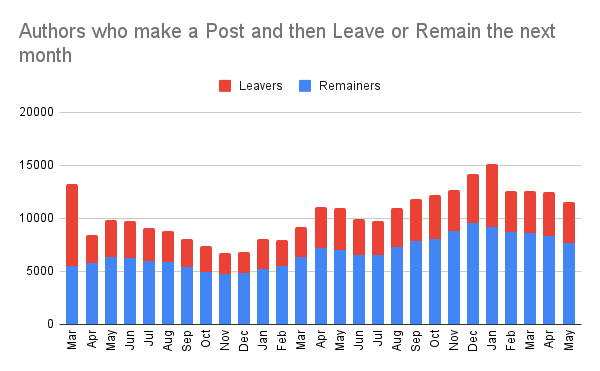
There is not much insight that pops out immediately, aside from the obvious number who did not transition from Steem. Here is a chart which shows the proportion each month.
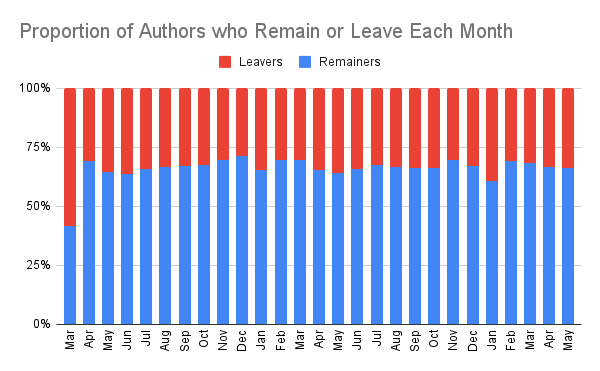
The most remarkable thing is the consistency. Aside from the exodus fork, the number of authors who remain month on month never exceeds 70%, but never drops below 60% either. Hive consistently loses 30-40% of active authors each month.
Activity
Ok, so let's try and distinguish what differences there are between those who leave and those who stay. I would expect that remainers are more likely to be long time users, who are more likely to make more posts each month.
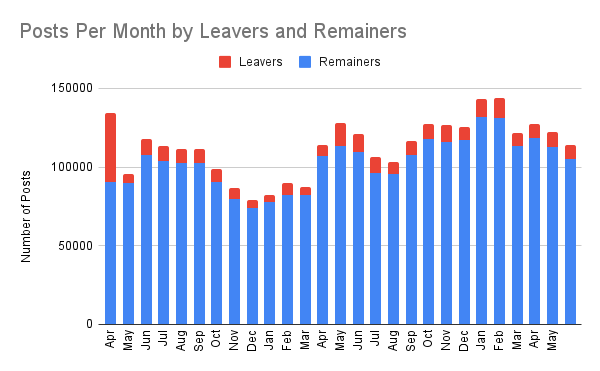
Indeed, we can see that those who remain are also making a larger number of posts.
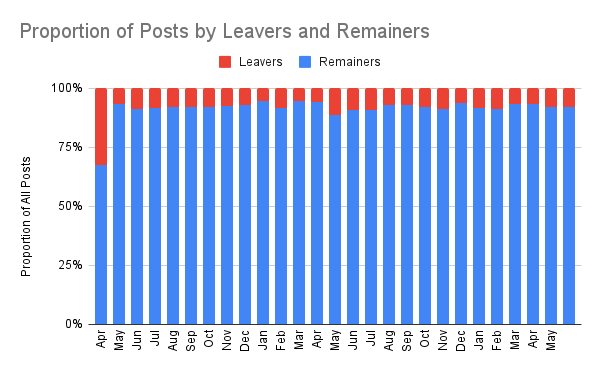
The proportion chart again shows it is fairly consistent - outside of the fork leavers create at least 5% and at most 11% of all posts.
Rewards
I would also expect that those who remain are the authors making rewards, so let's take a look.
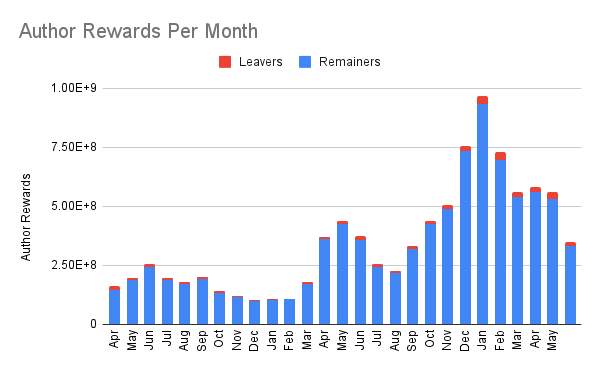
Indeed, the proportion is even lower for rewards than it is for number of posts.
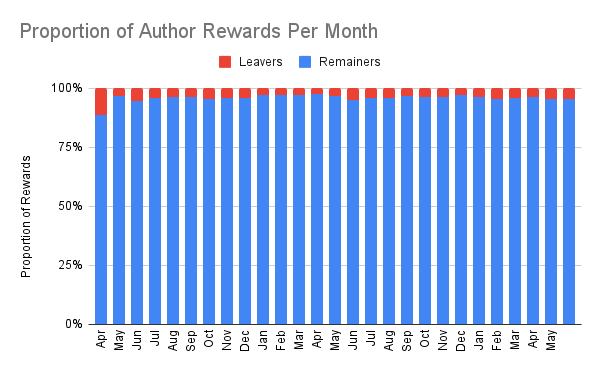
5% is the very most that leavers get per month.
How about rewards per post?
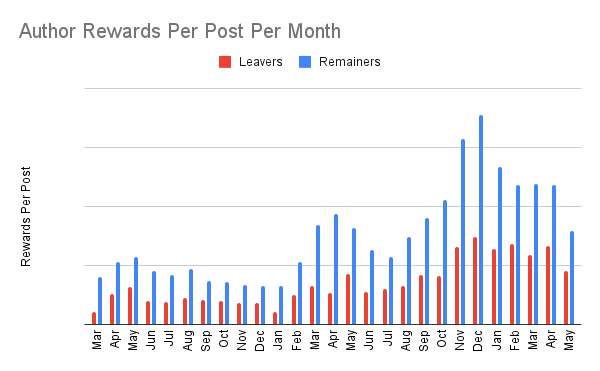
Aha! This might be the first really interesting chart here. The previous charts all showed only one story: consistency. 30% of users leave consistently each month. Users who leave make a consistent proportion of posts and they get a consistent proportion of rewards. But one thing is NOT consistent: how much they are paid per post per month. In late 2021, Hive was paying out several times what it was paying a year earlier - yet the people who left were being paid more than the people who stayed were being paid in 2020.
This seems to strongly suggest that absolute reward values are NOT what encourages people to leave or stay. If it was about absolute rewards, we would have higher proportions of users staying during the bull markets when everyone is earning more. That's not the case - authors appear to leave just as often when they're well rewarded - if anything they are slightly more likely to leave when they are receiving more rewards.
That's not to say author rewards don't matter for user retention, but if they do, it would be some other aspect than the absolute amount. For example, it could come down to expectations vs reality, or making more rewards than other users, or making it to the trending page etc.
I was planning to explore some more aspects, such as the account age of leaving vs remaining authors, as well as number of votes and comments, but I will leave it at this for now. Thanks for reading if you have gotten this far. All data in this post was gathered using @hivesql.
It was the engagement that got me hooked 5 years ago on steemit. The rewards were in the form of praise and not so much monetary.
Now it's the total opposite, my post's get handsomely rewarded with dollars but the engagement is just not there in the same way. You only have to look at most of the top trending posts to see that that the engagement levels have dropped big time.
I would say it's a mixture of politics and lack of engagement that makes people turn their backs on this hugely potential blockchain.
This is only my opinion, which doesn't hold any credibility as I have only just returned after a few years away.
Good job for raising this issue @demotruk 👍
More interesting data. I wonder how much engagement matters for making people stay. Some get small rewards, but they never comment and so get hardly any responses. I have stopped supporting some people who never respond to comments. It just seems selfish to me, but you get different personality types on Hive. Someone could have fun analysing that based on how people behave.
I was planning to include the relationship between engagement and turnover in this post today, but didn't manage to. I hope to still look at it in a future post.
Here are the same charts for pre-fork Steem.
So far the only insight that stands out to me is that the problem was much worse in the days of Steem.
Holy crap the payouts per post were insane in July 2016... and everyone still left anyway...
Something I would be interested in seeing is how many of those that regularly made it to the trending page with their 'totally awesome' content dumped everything and left.
The worst offenders amongst them could be used as examples of what not to vote.
The curators that voted it to them are likely still here and still dominating trending if my guess is correct.
It would likely benefit us all to expose such behaviors.
RC runs out super quick after a few comments or posts. I'm curious about the stat of the number of accounts at 5 HP or less and 10 HP or less is. This is why RC delegation is such an important upgrade. Even more so if you're Splinterlands player as having enough RC will mean being able to play or not...
Very good point. I will see if I can investigate if RC's are a factor in people leaving. Will have to think about how I can determine that with the available data.
Luckily this should become a nonissue after the next HF with RC delegations.
There's a lot be said for how demotivating a sense of relative reward injustice can be.
Remember Exyle's double daily ritual of putting up something interesting and then a life update - like a picture of him grinning with his plate of steak or a 50 word update about his trip to the cinema with his dad - Boom! $40 a pop for those.
Seeing that made me want to leave back in the day.
Probably people look at my rewards now and feel the same!
I was planning to compare to the heady days of Steem, but the query I used was getting a bit excessive so I made sure to limit it to only 2020 and onwards. I would still like to do it if I can optimize the query, I'm not great at SQL.
I believe that we have gotten much better at "relative rewards" today and also fair compensation compared to the days of Steem.
Oh yes I think things are much better too!
Great analysis series this btw, keep them coming!
I actually just made the charts for the days of Steem. TLDR: Yes, it was worse back then, we have gotten a lot better.
https://peakd.com/hive-133987/@demotruk/re-demotruk-redt1p
In my opinion, there are two types of newcomers, the ones that put all their attention and efforts into understanding the ecosystem without the urgency of getting rich quickly and the ones that come for the idea of HIVE as a faucet with chances of getting rich quickly.
When the seconds realize that it is not easy to get rewarded in the platform, they quit.
I onboarded several people in my 5 years here and I can tell you that their average activity time on HIVE was 1 week, even taking into account my help and lessons they quit putting as an excuse the lack of time.
Personally, I think one month definition for leavers may not be wide enough.
I'll go for three or two months. Sometimes, people are busy for some reason.
Maybe you can explore two or three months definition and compare if it's much different than the one month. If not, then I guess my theory is wrong and will have to be happy with one month definition.
I am running a query now to test this idea. Adding months increases the complexity of the query so I will only check from 2021 onwards to limit the scope, but I can make a chart from the data and compare it to the one in the original post.
Original chart:
New Chart:
In the 1 month definition it is between 30 and 40% each month, in the 3 month definition it is between 25% and 33% each month. So the shorter term absenses make up about 1 in 5 to 1 in 4 among 'leavers'.
Thanks, not so unexpected. Interestingly, it sort of smoothen things a little.
Personally, I thought 3 months is a good cut off because our maternity leave here used to be 3 months (it's 4 months now). I think it's possible to have a parameter to default the number of months you want to take (be it 1 or 3) in the SQL query. You can change it later when you think when you want to adjust the definition
On your remainders and leavers, people that post, does posting include those that just comment? Example myself, I had some serious health stuff to deal with and since March I have only made one "post", but I am still here reading, enjoying content, voting, and commenting.
No, it doesn't. I had to put some limitations on my query, so I chose to limit it only to top-level comments ie. posts. This does mean that it treats some people as "leavers" when they have in reality only reduced their level of activity.
There are a lot of people that are infrequent posters, but still comment. I don't see just voting as an active user since that can all be automated, but it is pretty hard I think to automate honest comments.
I agree, the only reason I filtered down to posts is because my query has to cross all comments against each other. As a result it was too large a dataset and the query wasn't finishing. Applying some limitations allows me to run the query and get some meaningful results, even if it would be preferable to have commenters included as still active.
But on the positive side, by using top level comments (ie. posts) as the standard for both months, it is using just one standard of what can be considered 'active'.
Great data and insights as usual. So basically, rewards aren’t the problem, and we need to encourage people to stay motivated and not quit?
We can't conclude that rewards aren't the problem, but we can at least conclude that absolute value of rewards does not seem to be the problem. ie. Simply increasing author rewards or having a higher price will not fix our user retention problem.
There is something (or some set of things) which is causing us to basically lose 30% of authors every month, relying on new authors or returning authors to replenish numbers. What that/those problems are, are not clearly identified here.
Unfortunately I believe a big percentage to that may be from some abusers that seem to focus on creating fake intro posts, mostly either stolen from steem or other places of people holding up a sign that they lazily edit. These abusers all have one thing in common, they create one post and do nothing else after that so it may be a big part of your stats of leavers.
Good point. It might not be straightforward, but it may be possible to do some sampling and estimate what proportion of accounts are just catfish style accounts that are not desirable in the first place.
Don't draw any conclusions yet. I think a lot of it is RC related. I don't know if you play Splinterlands or not but I think new accounts get like 2-5 HP powered up or something. They try posting or commenting a few times and then find out they can't actually play any more because of insufficient RC.
Users are leaving due to the fall of coins on the crypto market. The drop in Hive price is more important than the drop in post reward.
Price factor affects how many join (or return from absence), but the proportion to leave is fairly consistent regardless of the price, as can be seen in the data.
Absolutely amazing stats. Thanks for sharing! Looking at the last diagram, I agree that the absolute rewards may not play a critical role, but how about relative rewards? I am curious that, does the reward disparity between leavers and remainers gets larger, or does it also remain consistent over time? how does the reward disparity relate to retention? thinking you might have some preliminary answers with additional calculations based on the current stats.
I'll run the numbers on this when I get the chance.
Reward Disparity = Average reward per post for leavers divided by average reward per post by remainers.
Proportion of authors that leave = leaver count divided by all authors count.
The correlation between the two datasets is -0.182. First data point is probably best ignored because it is the month of the Hive exodus hard fork.
This is the average reward per post of a remainer - average reward per post of a leaver. They're in reward units, so it's not measured exactly in dollars.
Absolute reward disparity has a correlation of 0.098 with the proportion of authors that leave.
Wow, thank you so much for the speedy calculations! Love the results. The absolute reward disparity aligns well, while the relative measure seems to be a bit surprising. It seems like if more people leave in time t, more reward disparity will be in time t+1.
Maybe the better way to represent the disparity is with remainer average reward per post divided by leaver average reward per post rather than the other way around. In that case the correlation changes from -0.182 to +0.182.
I think the most likely answer is that rewards are not actually a major factor in people leaving. There's a wide range of other possibilities. Anecdotally, among my family the reason almost all of them say they don't use it is because it's too hard to use. I think we'd be unlikely to find that answer with a SQL query though...
This is true. Also, for users to actually have "value" in this community, they must go through the learning curve. Otherwise, the votes or any other activities they may wish to perform do not mean much and could be easily ignored if they do not stake, at least from their own perspectives. This attribute of the community creates a psychological fear that prevents them from starting the journey. Ironically, for network effects to take off for any social media platform, those "free users" could be critical. I think somehow the community needs to find a way to make them feel valued as well.
Also, if you have some extra time to continue the analysis, it might be useful to take a look at the reward Gini coefficients as a measure of disparity. That's what I will do for my paper lol
The rewards earned on this comment will go directly to the people( @demotruk ) sharing the post on Twitter as long as they are registered with @poshtoken. Sign up at https://hiveposh.com.